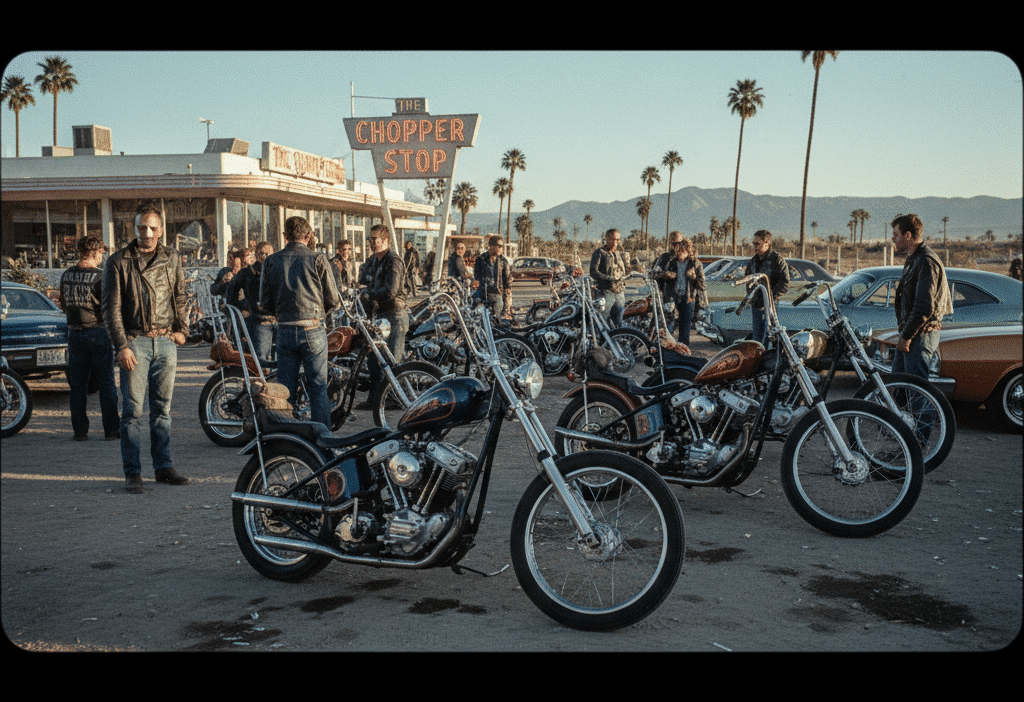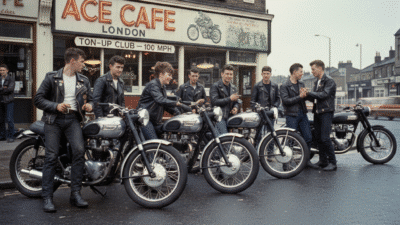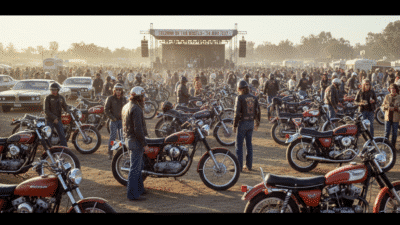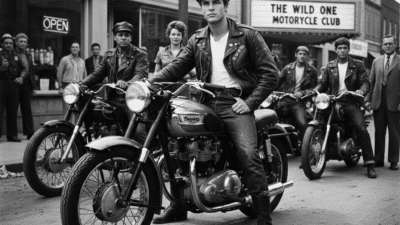The roar of an engine, the glint of chrome under an endless sky, and the unmistakable silhouette of a radically customized motorcycle against the open road – these images define an era. The 1960s were a crucible of social change, artistic expression, and a profound questioning of established norms. Amidst this cultural upheaval, a potent symbol emerged from the workshops and garages of America: the custom chopper. This wasn’t merely a mode of transport; it was a defiant statement, a rolling sculpture of individualism, and a vibrant emblem of the burgeoning counter-culture. The rise of custom choppers in the 1960s wasn’t just a trend; it was a revolution that irrevocably shaped motorcycle culture, popular imagination, and the very idea of freedom on two wheels.
The Echoes of Rebellion: Pre-Chopper Roots
To truly understand the 1960s chopper phenomenon, we must first glance back at its spiritual predecessors. Post-World War II America saw a surge in motorcycle ownership, particularly among returning GIs. These veterans, accustomed to modifying military equipment, brought a similar ethos to their civilian bikes, often Harley-Davidsons and Indians. They began to “bob” their motorcycles – stripping off unnecessary weight like front fenders, reducing rear fenders, and often lowering seats. The “bobber” was born out of a desire for speed and a sleek, minimalist aesthetic. It was a utilitarian modification, but it laid the groundwork for the more extreme customization that was to come.
As the 1950s progressed, a subculture of independent riders and early motorcycle clubs began to form. They valued camaraderie, freedom, and a distinct identity. While bobbers focused on performance and minimalism, the seeds of artistic expression were being sown. Riders started to experiment with paint, chrome, and subtle modifications that distinguished their bikes from stock factory models. This era fostered the idea that a motorcycle could be an extension of one’s personality, rather than just a machine.

The Chopper’s Genesis: A Radical Transformation
The transition from bobber to full-blown chopper was less an evolution and more a radical reinvention. The late 1950s and early 1960s saw builders take the minimalist approach of bobbing and push it to extreme, often impractical, limits. The term “chopper” itself is descriptive, implying the act of “chopping off” parts and reshaping the motorcycle from the ground up.
The fundamental philosophy behind a chopper was to remove anything deemed non-essential and then exaggerate the remaining elements for dramatic effect. This often involved:
- Extended Forks: Perhaps the most iconic chopper modification. Front forks were often extended by several feet, giving the bike a stretched, low-slung appearance. This wasn’t for handling improvement; it was purely for aesthetics and to create a visually striking profile.
- Raked Steering Head: To accommodate the extended forks and maintain some semblance of stability, the steering head angle (rake) was significantly increased. This pushed the front wheel further out, contributing to the bike’s long, stretched look.
- Small Fuel Tanks: Often called “peanut tanks,” these custom-fabricated fuel cells held minimal gas, sacrificing range for a streamlined, almost skeletal appearance.
- High Handlebars (Ape Hangers): These handlebars often extended well above the rider’s shoulders, forcing a unique, almost cruciform riding posture. Again, it was about style over comfort or ergonomic design.
- Sissy Bars: Tall, often elaborate backrests that extended high above the rear fender, serving both as a passenger backrest (if present) and a canvas for further customization or stylistic flair.
- Minimal Fenders: Front fenders were frequently discarded entirely, and rear fenders were often drastically cut down or reshaped, sometimes replaced with small, custom units.
- Hardtail Frames: Many choppers featured rigid rear suspensions (hardtails), meaning there were no rear shocks. This provided a lower ride height and a clean aesthetic but at the cost of rider comfort.
- Custom Paint and Chrome: The paint jobs became works of art – vibrant metal flakes, elaborate murals, pinstriping, and intricate designs turned each chopper into a unique expression. Chrome was applied liberally, catching the light and emphasizing the bike’s metallic elements.
This audacious approach to customization was a direct repudiation of the factory-produced, mass-market motorcycles. It was about creating something entirely unique, a personal statement that could not be bought off a showroom floor.

The Cultural Crucible of the 1960s
The 1960s provided the perfect fertile ground for the chopper’s ascent. It was a decade defined by rebellion, self-expression, and a deep-seated distrust of authority. Young people, disillusioned with suburban conformity and traditional values, sought alternative paths. Music, art, fashion, and even transportation became vehicles for this dissent.
Motorcycles, particularly customized ones, became a powerful symbol of this burgeoning counter-culture. They represented:
- Freedom and Mobility: The open road symbolized escape from societal constraints, a journey into the unknown, and the pursuit of personal liberty. Choppers, with their stripped-down aesthetic, embodied this raw, untamed freedom.
- Individualism: In an era of mass production, a custom chopper was an antidote to uniformity. Each bike was a testament to its owner’s vision, craftsmanship, and willingness to stand apart.
- Anti-Establishment: Stock motorcycles were associated with mainstream society. Choppers, by their very nature, challenged this. They were loud, often illegal (due to modifications), and visually provocative.
- The Outlaw Image: While not all chopper riders were outlaws, the association with outlaw motorcycle clubs (OMCs) like the Hells Angels, who frequently rode heavily customized Harleys, lent choppers an undeniable edge and mystique. This image, often amplified by media, further solidified the chopper as a symbol of defiance.
- A DIY Ethos: Choppers were largely built in garages, by amateur and professional builders alike. This do-it-yourself spirit resonated with a generation that valued authenticity and hands-on creation.
This era of innovation and customization wasn’t limited to just motorcycles. The automotive industry itself was undergoing significant changes, with new ideas constantly emerging. For example, while not directly related to choppers, the spirit of pushing boundaries and challenging conventional design can be seen in broader discussions about automotive patents that changed everything and the relentless pursuit of innovation [https://enginestories.com/automotive/automotive-patents-that-changed-everything-the-innovations-behind-the-scenes/]. This drive to rethink and rebuild was a hallmark of the 60s.
Iconic Machines and the Masters Behind Them
While countless choppers were built in backyard garages, some machines and their creators achieved legendary status, cementing the chopper’s place in history.
- Arlen Ness: Often dubbed the “King of Custom Bikes,” Ness began customizing bikes in his garage in the late 1960s. His innovative designs, often incorporating intricate metalwork, elaborate paint, and powerful engines, pushed the boundaries of what a motorcycle could be. He blended artistry with engineering, creating machines that were both beautiful and rideable.
- Von Dutch (Kenny Howard): Though primarily known for his pinstriping and artistry on cars and bikes, Von Dutch’s influence on the aesthetic of custom culture, including choppers, was immense. His distinctive eye-ball logo and freehand pinstriping became synonymous with the custom scene.
- Easyriders Magazine: Launched in 1970, this magazine quickly became the bible for chopper enthusiasts. It showcased the wildest custom builds, celebrated the lifestyle, and provided a platform for builders to share their creations, further fueling the custom movement.
However, no single event or creation popularized the custom chopper more than the release of a specific film in 1969.
The “Easy Rider” Phenomenon: Choppers Go Mainstream
The 1969 counter-culture film Easy Rider, starring Peter Fonda, Dennis Hopper, and Jack Nicholson, was a watershed moment for custom choppers. The movie followed two bikers, Wyatt (Captain America) and Billy, on a cross-country journey through the American South and Southwest, seeking freedom and encountering societal prejudice.
The true stars of the film, arguably, were the motorcycles:
- Captain America: Wyatt’s iconic chopper, a heavily modified Harley-Davidson Panhead. It featured a wildly extended front fork, “ape hanger” handlebars, a distinctive flag motif on its gas tank and rear fender, and a chrome “sissy bar” that soared high above the seat. This bike became the quintessential image of a chopper.
- Billy Bike: Billy’s bike, also a Panhead, was equally striking with its flame paint job on a dark background.
Easy Rider didn’t just showcase choppers; it wove them into the fabric of a powerful narrative about freedom, rebellion, and the tragic loss of innocence in America. The bikes weren’t just props; they were central to the characters’ identities and the film’s message.
The film’s enormous success propelled choppers from a niche subculture into the global consciousness. Suddenly, everyone knew what a chopper was. It inspired a generation of aspiring builders and riders, and its imagery became synonymous with the spirit of the open road and individual liberty.

Pros and Cons
| Pros | Cons |
|---|---|
| – Unparalleled Individuality: Each chopper is a unique work of art, reflecting the owner’s personal vision and craftsmanship. | – Compromised Handling: Extended forks and raked frames drastically alter steering geometry, making them challenging to maneuver, especially at low speeds. |
| – Cultural and Historical Significance: Choppers are enduring symbols of rebellion, freedom, and a pivotal era in American counter-culture. | – Reduced Comfort: Hardtail frames, low seats, and high handlebars contribute to a less comfortable ride, particularly on long journeys. |
| – Community and Brotherhood: Building and riding choppers fosters a strong sense of community among enthusiasts who share a passion for unique bikes. | – Potential Legality Issues: Many extreme modifications (like excessively long forks or high handlebars) may not be street-legal in all jurisdictions. |
| – Raw Riding Experience: The stripped-down nature offers an unfiltered connection between rider, machine, and road, appealing to purists. | – Practicality Sacrificed: Small fuel tanks, minimal storage, and less reliable older engines can make them less practical for daily commuting or touring. |
| – Artistic Expression: Choppers serve as a canvas for creative expression through paint, chrome, and custom fabrication. | – Maintenance Demands: Custom parts can be difficult to source, and heavily modified vintage engines often require more frequent and specialized maintenance. |
The Technical Heart of the Beast: Building a Chopper
While aesthetics dominated, the underlying mechanical choices were crucial. Harley-Davidson motorcycles, particularly the Panhead and Shovelhead engines, were the undisputed kings of the chopper world in the 1960s. Their robust V-twin architecture, ample torque, and distinctive sound made them ideal platforms for customization. Builders would often acquire derelict Harley frames and engines, tearing them down to bare components before rebuilding them with custom parts.
The process of building a chopper involved a blend of mechanical skill, artistic vision, and sheer ingenuity. Builders often had to fabricate many parts from scratch or heavily modify existing ones. This hands-on approach differentiated them from simply buying off-the-shelf accessories.
- Frame Modification: The stock frame was often cut and welded to achieve the desired rake and stretch. A “hardtail conversion” involved removing the rear swingarm and welding a rigid rear section, eliminating the rear suspension.
- Engine & Drivetrain: While Harley engines were preferred, significant work might go into tuning, porting, and adding custom exhausts to enhance both sound and (sometimes) performance. The
evolution of early motorcycle enginesprovides context on the mechanical foundations these builders were working with [https://enginestories.com/moto/the-evolution-of-early-motorcycle-engines/]. - Wheels & Tires: Spoked wheels were common, often with a smaller front wheel and a larger, wider rear wheel.
- Electrical System: Often simplified to the bare essentials, sometimes with exposed wiring adding to the raw aesthetic.
- Braking: Early choppers often featured rudimentary braking systems, sometimes even a single rear drum brake, reflecting the era’s focus on form over ultimate function.
The level of innovation and custom fabrication in the chopper scene was remarkable, pushing the boundaries of what was possible with existing motorcycle technology. In a way, it mirrored the broader spirit of innovation seen in the automotive industry, where even automotive icons like the 10 cars that changed everything emerged from a culture of relentless development [https://enginestories.com/automotive/automotive-icons-the-10-cars-that-changed-everything/].

Beyond the Bike: The Chopper Lifestyle
Riding a chopper in the 1960s was more than just owning a motorcycle; it was adopting a lifestyle. It was about shared experiences, the camaraderie of the road, and a distinctive sense of belonging.
- Road Trips and Rallies: Chopper riders embarked on epic road trips, crisscrossing the country, often heading to burgeoning motorcycle rallies that became annual gatherings. These events were a vibrant display of custom bikes, a celebration of the culture, and a chance to meet like-minded individuals.
- Fashion and Aesthetics: The chopper lifestyle also influenced fashion. Leather jackets, denim vests adorned with patches, boots, and long hair or bandanas became associated with the image. This look, raw and rebellious, complemented the bikes themselves.
- Music and Art: The counter-culture music of the 1960s, from rock and roll to psychedelic rock, provided the soundtrack for the chopper generation. The intricate paint jobs on the bikes often reflected the vibrant, mind-bending art prevalent at the time.
- A Sense of Community: Despite the individualistic nature of the bikes, chopper culture fostered strong bonds. Riders often helped each other with mechanical issues, shared stories, and built a tight-knit community on the fringes of mainstream society.

The Enduring Legacy and Influence
The 1960s might have been the golden age of the custom chopper’s rise, but its influence continued to resonate for decades. The aesthetic evolved through the 1970s and 80s, with different styles emerging, but the core principles of extreme customization and personal expression remained.
Today, the spirit of the 1960s chopper lives on. Contemporary custom builders draw inspiration from those early trailblazers, continuing to push boundaries while honoring the iconic designs. Vintage choppers from the era are highly sought after by collectors, viewed not just as vehicles but as significant pieces of cultural and automotive history.
The chopper’s legacy extends beyond niche motorcycle culture. It influenced mainstream design, inspired countless films, songs, and works of art, and forever ingrained itself as a powerful symbol of American freedom and rebellion. It showed that a machine could be more than its function; it could be a statement, an art form, and a mirror to the soul of an era. The impact of such personal vehicles on culture, much like the broader evolution of American pickup trucks reflected changing societal needs and desires [https://enginestories.com/history/the-evolution-of-american-pickup-trucks/].
Conclusion
The 1960s were a period of unprecedented change, and the custom chopper emerged as a powerful, gleaming symbol of that transformation. From its roots in post-war bobber culture to its explosive mainstream debut in Easy Rider, the chopper embodied the era’s yearning for individuality, freedom, and defiance against conformity. It was a canvas for mechanical artistry and a testament to the DIY spirit, built by passionate individuals who dared to reimagine what a motorcycle could be.
More than just a mode of transport, these machines were cultural artifacts, reflecting the rebellious heart of a generation. The extended forks, loud pipes, and vibrant paint jobs were not just stylistic choices; they were declarations of independence. The legacy of the 1960s chopper continues to inspire, reminding us that true freedom often comes on two wheels, built by hand, and ridden with an unwavering spirit. Experience the enduring allure of these iconic machines, whether by admiring a perfectly restored vintage model or by delving into the rich history of those who first dared to chop and ride.
Frequently Asked Questions
What defined a custom chopper in the 1960s?
Custom choppers of the 1960s were defined by radical modifications to stock motorcycles, typically Harley-Davidsons. Key characteristics included greatly extended and raked front forks, high “ape hanger” handlebars, small “peanut” fuel tanks, minimalist or absent fenders, tall “sissy bars,” and often a rigid “hardtail” frame without rear suspension. These modifications prioritized aesthetics and individual expression over practicality.
How did the “Easy Rider” movie impact the rise of choppers?
The 1969 film Easy Rider played a monumental role in catapulting custom choppers into mainstream consciousness. The iconic motorcycles ridden by Peter Fonda (Captain America) and Dennis Hopper (Billy Bike) became instant symbols of freedom and rebellion. The movie’s commercial success exposed choppers to a global audience, inspiring a generation of riders and builders and cementing their status as cultural icons.
Why were Harley-Davidson motorcycles the preferred choice for choppers?
Harley-Davidson motorcycles, particularly models with Panhead and Shovelhead engines, were the preferred choice for 1960s choppers due to several factors. Their robust V-twin engines offered ample power and a distinctive sound, their frames were relatively easy to modify, and their ubiquity made them accessible platforms for custom builders. The strong, low-end torque of these engines also suited the often-heavy and unwieldy nature of the modified bikes.
What was the cultural significance of choppers in the 1960s?
In the 1960s, choppers became powerful symbols of the counter-culture movement. They represented individualism, anti-establishment sentiment, and a yearning for freedom on the open road. Their rebellious aesthetic challenged conventional norms and resonated with a generation seeking to break away from traditional societal structures. They were also associated with a DIY ethos and a strong sense of community among riders.
Are custom choppers legal to ride on public roads today?
The legality of custom choppers on public roads varies significantly by jurisdiction. Many modifications popular in the 1960s, such as extremely long fork extensions, excessively high handlebars, or the absence of crucial safety equipment (like front brakes or proper lighting), may not meet modern safety regulations or state vehicle codes. It is crucial for chopper owners to research and ensure their specific modifications comply with local laws.
Who were some influential figures in the 1960s chopper movement?
Key figures in the 1960s chopper movement included custom bike builders and artists who pushed the boundaries of design. Arlen Ness, often called the “King of Custom Bikes,” was highly influential with his innovative and artistic builds. Von Dutch (Kenny Howard) was renowned for his pinstriping and custom paintwork that became synonymous with the custom scene. Publications like Easyriders Magazine also played a crucial role in showcasing builders and their creations.



